Who Controls the User Experience? AMD’s Carrizo Thoroughly Tested
by Ian Cutress on February 4, 2016 8:00 AM ESTBenchmark Results: Professional and OpenCL
Here are our results from our Professional and OpenCL tests. A reminder of our systems, including their graphics:
| System Overview | ||||
| µArch | APU + GPU | Memory | Channel | |
| HP Elitebook 745 G2 | Kaveri | A10 PRO-7350B (19W) R6, 384 SPs, 533 MHz |
8 GB | Dual |
| HP Elitebook 745 G3 | Carrizo | PRO A12-8800B (15W) R7, 512 SPs, 800 MHz |
4 GB | Single |
| Toshiba Satellite E45DW-C4210 |
Carrizo | FX-8800P (15W) R7, 512 SPs, 800 MHz |
8 GB | Single |
| HP Pavilion 17z-g100 |
Carrizo | A10-8700P (15W) R6, 384 SPs, 800 MHz |
8 GB | Single |
| Lenovo Y700 | Carrizo | FX-8800P (15W) R7, 512 SPs, 800 MHz R9 385MX, 512 SPs, 900-100 MHz |
16 GB | Single |
PCMark 08
PCMark08, developed by Futuremark, is a simple press play and run benchmarking tool designed to probe how well systems cope with a variety of standard tasks that a professional user might encounter. This includes video conferencing with multiple streams, image/file manipulation, video processing, 3D modelling and other tools. In this case we take the three main benchmark sets, Creative, Home and Work, and run them in OpenCL mode which aims to take advantage of OpenCL accelerated hardware. For fun we also put in the PCMark08 Storage workset.
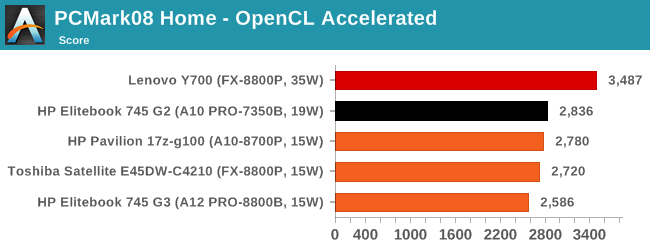
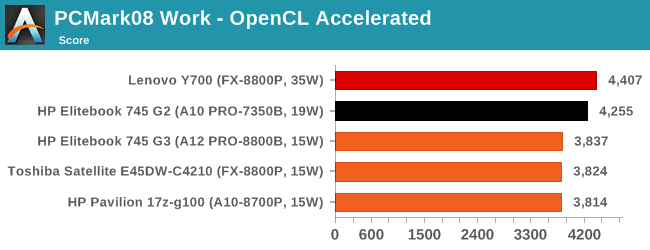
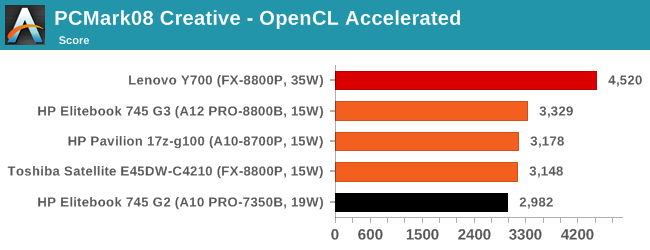
Both of the Home and Work tests show something starteling in the Kaveri system beating all the 15W Carrizo parts. This comes back to what we saw on WebXPRT on the last page – these workloads are very bursty in nature, requiring the system to wake up, run a small amount of work, and go back to sleep. It would seem that this requires a lot more effort from the Carrizo platforms than the Kaveri ones (perhaps by nature of the lower idle power draw starting point on Carrizo) which impacts time critical performance metrics.
If we take the CPU frequencies of the two Elitebook systems, starting with the 745 G2 (Kaveri)
Here the standard frequency tends to be in the 3300 MHz region, moving down to lower frequencies when more threads are needed. But for the 745 G3 (Carrizo):
Here the CPU frequency is obviously mostly at the 2500 MHz mark, sometimes bursting up to 3400 MHz (It’s actually more of a 2:1 split in favor of 2500 MHz).
You might argue that the temperature of the design might be to blame. Both Elitebooks are in the same chassis, so let us see:
(take note of the scales)
Here it shows the G2 wanting to stay below 60C, whereas the G3 is happy to go almost to 80C, albeit with an average temperature which is nearer 50C. This means that the G2 can arguably keep the higher frequencies for longer.
Just to weigh in on the other 15W Carrizo designs in the Toshiba Satellite and HP Pavilion:
In both cases, similar to the G3, the main frequency for the test is actually the lower 2500/2300 frequency, with the system moving up to the higher frequency state around a third of the time, rather than staying at the higher state and moving back down. This is what is causing the Kaveri system to win out in these sorts of workloads (though likely at a power penalty).
On the storage front, having a mechanical drive is a killer here.

Agisoft Photoscan
Photoscan is professional software that takes a series of 2D images (as little as 50, usually 250+) and 'performs calculations' to determine where the pictures were taken and if it can create a 3D model and textures of what the images are of. This model can then be exported to other software for touch-ups or implementation in physics engines/games or, as the reader that directed me to it, national archiving. The tool has four phases, one of which can be OpenCL accelerated, while the other three are a mix of single thread and variable thread workloads. We ran the tool in CPU only and OpenCL modes.
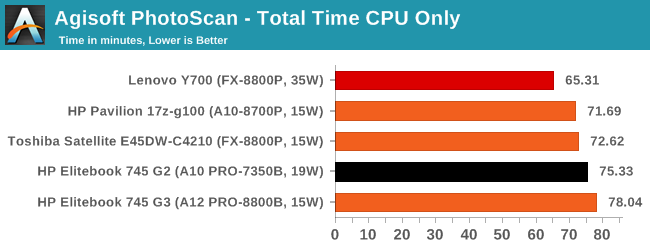
When pure CPU performance matters, having the higher thermal headroom matters most. But moving it to the OpenCL mode shows that those extra TDP points can matter a lot on load balancing:
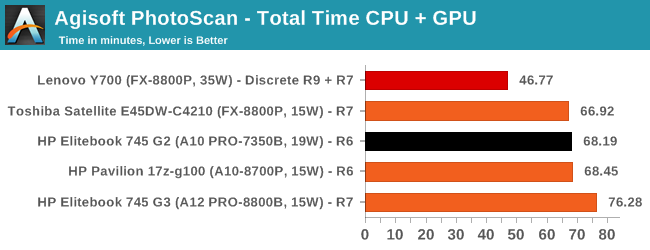
There are two things to note here. One, something seems to have gone very wrong with the G3, and I’m sure those numbers are erroneous and need to be re-run or the 4GB of memory is actually a hindrance here. The second is that the combination R7/R9 graphics in the Lenovo, despite not being in Crossfire, can both be used in OpenCL mode. This pushes a speed up of almost 30%.
Linux Bench
Linux Bench is a collection of Linux based benchmarks compiled together by ServeTheHome. The idea for this is to have some non-windows based tools that are easy enough to run with a USB key, an internet connection and three lines of code in a terminal. The tests in Linux Bench include standard synthetic compute, compression, matrix manipulation, database tools and key-value storage.
Unfortunately Linux Bench refused to run on any of the HP systems for relatively unknown reasons – the fact that it was all the HP models perhaps means that there is something firmware related which is causing the LiveCD to not boot properly. Nonetheless, the results are here for completeness.
| Linux Bench | ||
| Toshiba Satellite E45DW-C4210 (15W) |
Lenovo Y700 (35W) |
|
| C-Ray Hard Test / seconds | 365 | 267 |
| 7-Zip Compression MIPS | 5718 | 6110 |
| 7-Zip Decompression MIPS | 7320 | 9733 |
| NAMD (steps per time) | 1.72 | 2.46 |
| NPB MOPS (per sec per thread) | 365 | 321 |
| OpenSSL Sign | 220 | 296 |
| OpenSSL Verify | 13518 | 19465 |
| Redis 1 | 13210 | 12034 |
| Redis 10 | 41494 | 38760 |
| Redis 100 | 33445 | 31949 |






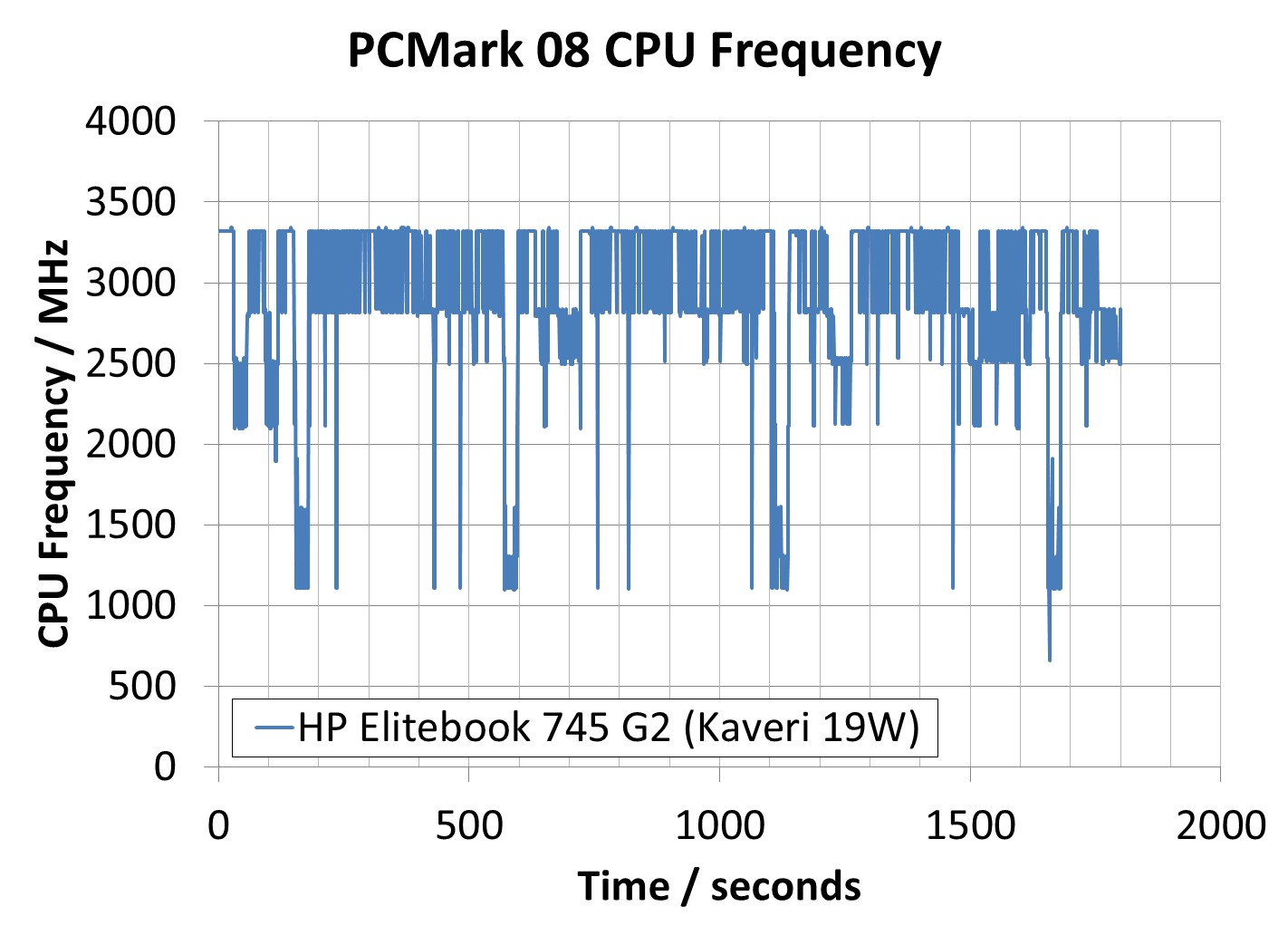

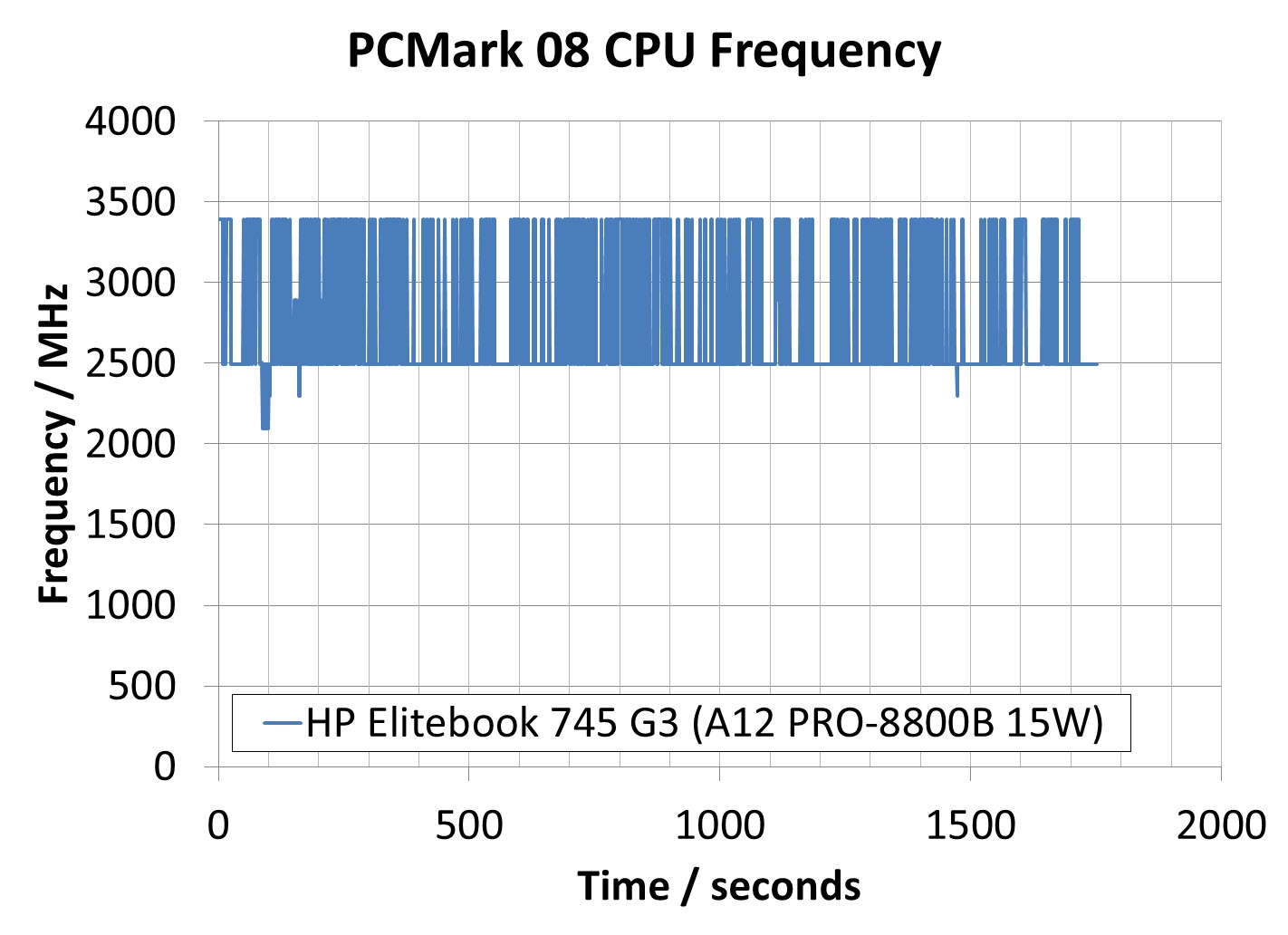
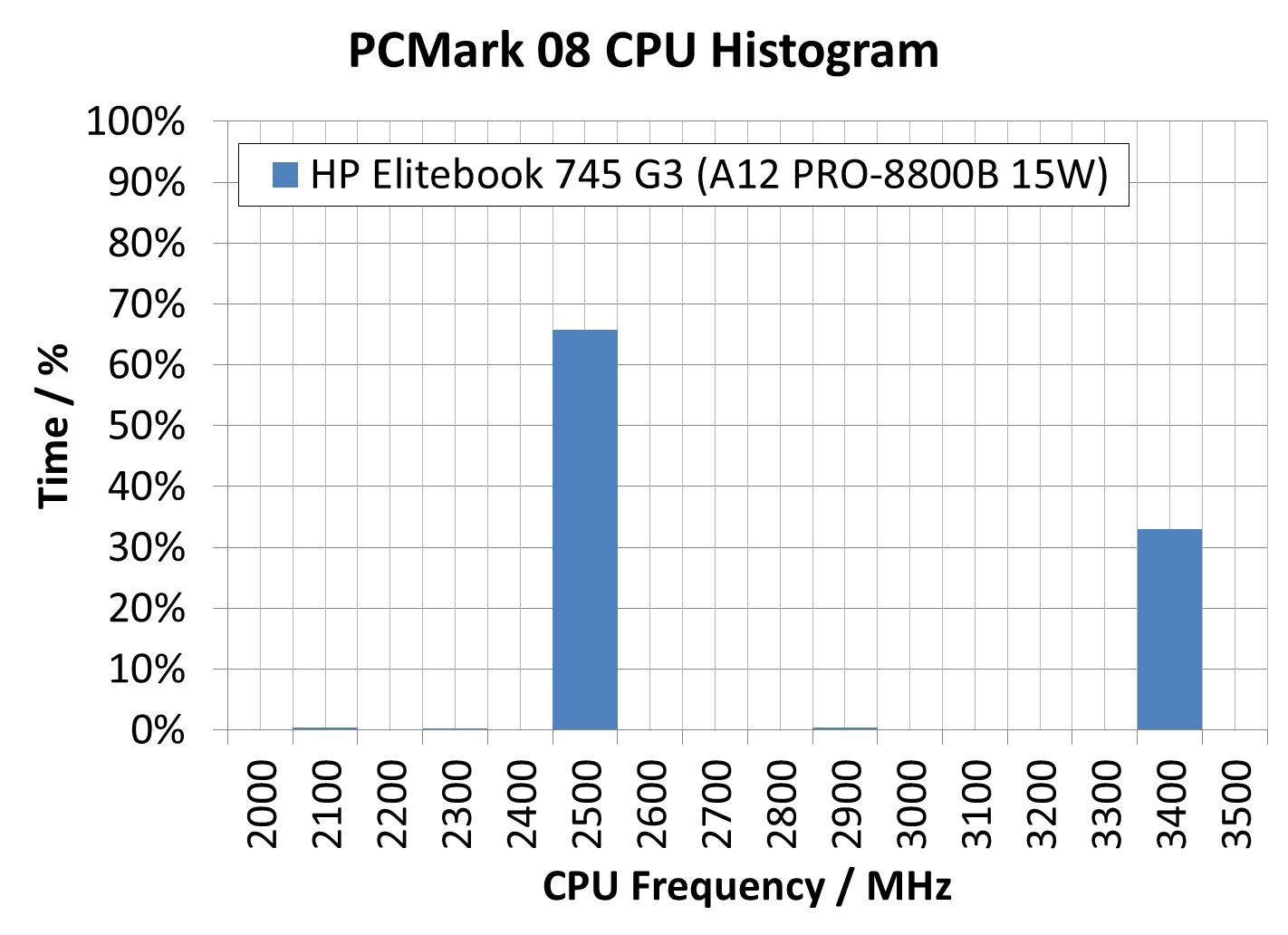

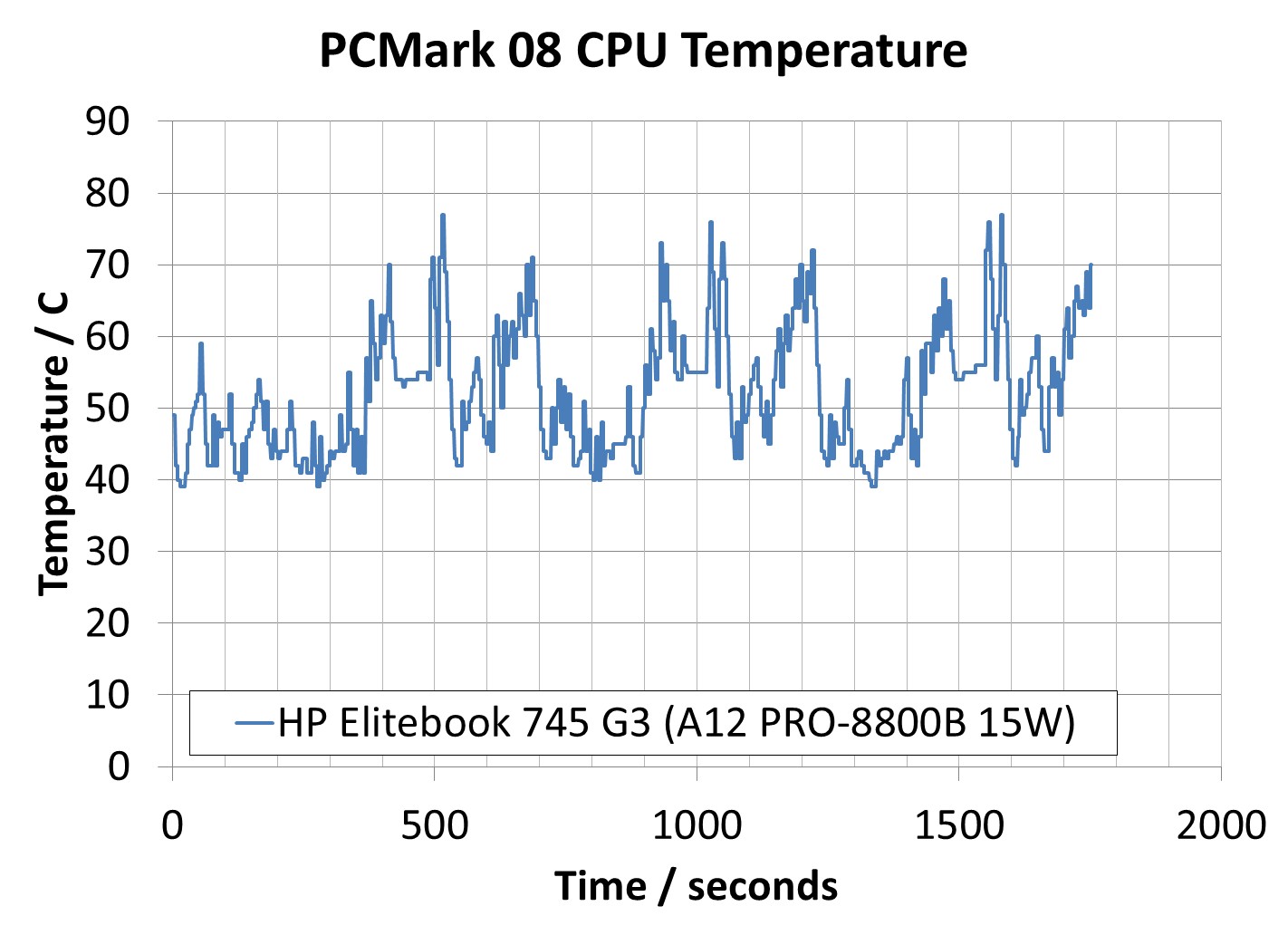










175 Comments
View All Comments
basicmath - Saturday, February 6, 2016 - link
can you post a link to those dual channel benchies please :)basicmath - Saturday, February 6, 2016 - link
actually just saw the notebook check graph, that is a considerable increase in performance!zodiacfml - Sunday, February 7, 2016 - link
Right! The review should have included dual channel performance. Going through the review, I thought Intel finally came close with AMD in graphics performance. With dual channel, Carrizo is well ahead in gaming benchmarks at nearly half the price.extide - Thursday, March 24, 2016 - link
AMD does not have a partnership with Samsung. GF does, but GF is, now, a separate company.Gc - Saturday, February 6, 2016 - link
Anandtech: how did you determine that the Y700 pre-production unit that you tested was accessing its two memory cards through a single channel only? Are you simply reporting what AMD told you, or is there a test that readers can use to check production laptops, and other machines? (Might the two memory cards be mismatched in some way, so the processor backed off to single channel mode?)typo:
s/ R9 385MX / R9 M385X /
Ian Cutress - Saturday, February 6, 2016 - link
Aside from being told directly, I did memory bandwidth testing and other software indicators (CPU-Z, AIDA, etc). Both modules were matched, I took them out and had a look.basicmath - Saturday, February 6, 2016 - link
@Ian Cutress, any reason you didn't put an extra 4GB stick in the G3 745? Seems like a really simple thing to do and would have given a really useful graphical comparison. I guess you guys are too poor to have a stick floating around!Ian Cutress - Saturday, February 6, 2016 - link
Aside from your snarky comment, your answers are explained in the review.The laptops were tested as sold. This is a review on the user experience of these devices. As shown on the Carrizo vs Core page, device after device from Carrizo comes by default with a single stick of memory. Most users who pick a device and go don't want to understand why their UX is the way it is, it just needs to work when they buy it.
I'd also like to mention that testing five laptops with a our suite of tests plus power testing and thermal testing in a single week without an opportunity to revisit is mightily tough for one person who doesn't have access to all their normal gear (testing was done on location, as mentioned), and adding in more variables extrapolates testing time which I didn't have.
We'll be doing further testing for Carrizo, specifically on generational updates, when the Athlon X4 845 comes out. I'm hoping to rope in an R-Series Carrizo platform as well (with IGP) to test DDR3/DDR4 comparison points.
basicmath - Saturday, February 6, 2016 - link
Dude, you highlighted the fact that the 512 core Carrizo chip was running on a single channel, weren't you even slightly curious to find out how it performed on dual channel? It's like reviewing a water proof phone and not trying to drown it!erple2 - Sunday, February 7, 2016 - link
No, its like testing a phone as it came from the factory, then not paying for some third party "waterproofing" company to waterproof the phone and testing it underwater.